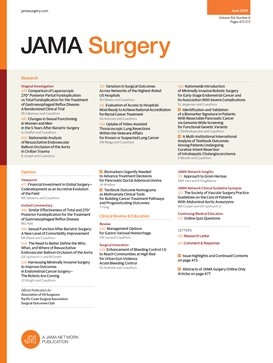生物补片与合成补片在腹腔镜腹股沟疝修补中的应用
IF 14.9
1区 医学
Q1 SURGERY
引用次数: 0
摘要
重要性腹股沟疝修补术后慢性疼痛和复发是相关并发症。生物网被认为是一种可吸收的替代人工植入物,可以减少术后疼痛。目的比较生物补片和合成补片在腹腔镜腹股沟疝自我控制修复中的术后疼痛和复发率。设计、环境和参与者腹腔镜腹沟疝修补中的生物与合成补片(BIOLAP)试验是一项多中心、随机、自我对照的临床试验,于2017年8月至2021年2月在21家经认证的德国疝中心进行。对491例成人原发性双侧腹股沟疝行腹腔镜修补术,分别使用1个生物补片和1个合成补片。数据分析时间为2023年7月至2024年6月。干预:患者在右侧随机接受生物或合成补片;对侧接受替代材料。所有患者都进行了标准化的腹腔镜修复(经腹腹膜前成形术或全腹膜外成形术),患者和评估者对补片分配都是盲目的。主要结果和测量主要结果是6个月时的疼痛强度(使用视觉模拟量表测量)和2年时的疝气复发。次要结局包括血肿、血肿、手术部位感染和患者满意度。结果491例患者(平均[SD]年龄58.5[14.1]岁,男性457[93.1%])中,生物补片和合成补片6个月疼痛无显著差异(静息时视觉模拟量表平均[SD]评分为0.3[0.9],两者P = 0.76)。然而,生物补片的2年复发率(53例复发[11.2%])明显高于合成补片(12例复发[2.5%])(P < 0.001)。生物补片的血清瘤率也显著高于合成补片(164例[33.4%]vs 106例[21.6%];P & lt; 0.001)。与合成补片相比,生物补片并不能减轻术后疼痛,但其复发率和血肿率明显高于人工补片。这些发现不支持在腹腔镜腹股沟疝修补术中常规使用生物补片。德国临床试验注册号:DRKS00010178本文章由计算机程序翻译,如有差异,请以英文原文为准。
Biological vs Synthetic Mesh in Laparoendoscopic Inguinal Hernia Repair
ImportanceChronic postoperative pain and recurrence are relevant complications after inguinal hernia repair. Biological meshes have been proposed as a resorbable alternative to synthetic implants that may reduce postoperative pain.ObjectiveTo compare postoperative pain and recurrence rates between biological and synthetic meshes in laparoendoscopic inguinal hernia repair using a self-controlled design.Design, Setting, and ParticipantsThe Biological vs Synthetic Mesh in Laparoendoscopic Inguinal Hernia Repair (BIOLAP) trial was a multicenter, randomized, self-controlled clinical trial conducted between August 2017 and February 2021 across 21 certified German hernia centers. A total of 491 adult patients with primary bilateral inguinal hernias underwent laparoendoscopic repair using 1 biological mesh and 1 synthetic mesh. Data analysis was performed from July 2023 to June 2024.InterventionPatients were randomized to receive a biological or synthetic mesh on the right side; the contralateral side received the alternate material. All patients underwent standardized laparoendoscopic repair (transabdominal preperitoneal plasty or total extraperitoneal plasty), and both patients and assessors were blinded to mesh assignment.Main Outcomes and MeasuresThe coprimary outcomes were pain intensity at 6 months (measured using the visual analog scale) and hernia recurrence at 2 years. Secondary outcomes included seroma, hematoma, surgical site infection, and patient satisfaction.ResultsAmong 491 patients (mean [SD] age, 58.5 [14.1] years; 457 [93.1%] male), there was no significant difference in pain at 6 months between biological and synthetic meshes (mean [SD] visual analog scale score at rest, 0.3 [0.9] for both; P = .76). However, the 2-year recurrence rate was significantly higher for biological meshes (53 recurrences [11.2%]) compared with synthetic meshes (12 recurrences [2.5%]) (P &lt; .001). Seroma rates were also significantly higher with biological meshes than with synthetic meshes (164 patients [33.4%] vs 106 patients [21.6%], respectively; P &lt; .001).Conclusions and RelevanceBiological meshes did not reduce postoperative pain but were associated with significantly higher recurrence and seroma rates compared with synthetic meshes. These findings do not support the routine use of biological meshes in laparoendoscopic inguinal hernia repair.Trial RegistrationGerman Clinical Trials Register Identifier: DRKS00010178
求助全文
通过发布文献求助,成功后即可免费获取论文全文。
去求助
来源期刊

JAMA surgery
SURGERY-
CiteScore
20.80
自引率
3.60%
发文量
400
期刊介绍:
JAMA Surgery, an international peer-reviewed journal established in 1920, is the official publication of the Association of VA Surgeons, the Pacific Coast Surgical Association, and the Surgical Outcomes Club.It is a proud member of the JAMA Network, a consortium of peer-reviewed general medical and specialty publications.
 求助内容:
求助内容: 应助结果提醒方式:
应助结果提醒方式:


